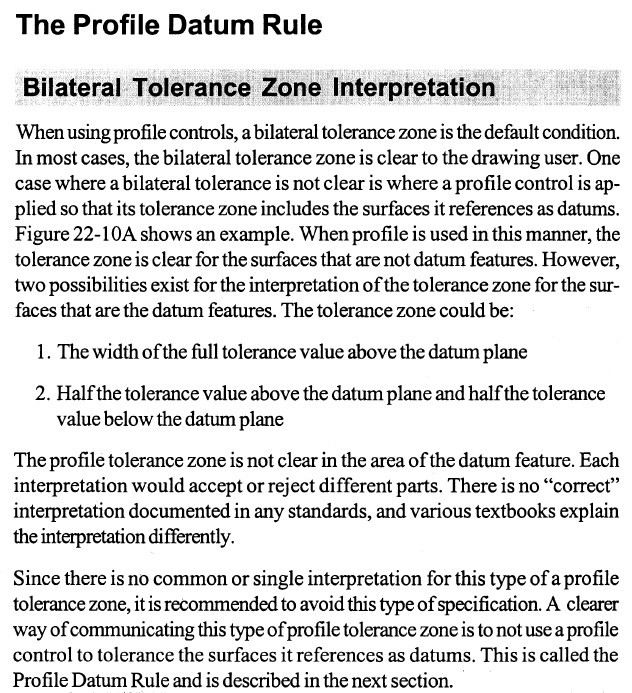dtmbiz,
I think I owe you a reply here.
First, before I refer to some of your statements, I would like to say that I agree that the tolerancing scheme shown in OP sketch in the referenced thread has been overcomplicated and most likely could have been modified/simplified (by removing datum feature B and C references from the all-around profile callout) to look much more traditionally and without risking too much that function of the part would have been grasped improperly.
In general, I also agree with you that referencing datum features in a FCF that includes them in that FCF's geometric control should be avoided (wherever possible), however you statement:
dtmbiz said:
Even though the standard does not specifically prohibit this practice that I can find, the standard does not appear to support this practice in the text, figures or intent relative to the DRF concept. IMO
is not fully correct. There are at least two examples in the Y14.5-2009 showing otherwise - figs. 4-25 and 9-7.
---
As for SeasonLee's example taken from AK's 'Advanced Concepts of GD&T' I am guessing it comes from a pre-2009 edition of the book. I am curious if today, in 2016, the author would wrote the same knowing that in 2009 the Y14.8 gave the interpretation (using datum targets example). So it is your full right to agree with option #1, but it is the option #2 that actually has been documented in any ASME standard. Unfortunately not in the Y14.5, which I think is the main issue here.
---
dtmbiz said:
As for your extension of principal in the case of Target datums carrying over to an entire datum feature;
and your view that the profile control covers the control of the DRF datum features control to each other; neither are practices that that I would recommend doing. Not saying conclusions are wrong. Just do not see how either adds any clarity to an interpretation.
Actually, I have used the "datum features self-referencing" scheme with datum targets quite often and with success for cast parts, because there is one big advantage behind doing this. It guarantees part-to-datum feature simulator repeatability during inspection of a part.
Using example, please take a look at fig. 4-48 from Y14.5-2009 (which, by the way, is unfortunately intentionally incomplete because we do not know how exactly the datum features A, B and C are controlled relative to each other), and picture what could happen if the secondary and tertiary datum surfaces B and C were controlled in a traditional way, that is, if B was controlled wrt to A only, and C was controlled wrt to A and B.
If someone was to set up the part only on 3 datum target flat-tipped pins A spaced apart as defined by basic dimensions in order to qualify both datum feature surfaces B, there would actually be infinite ways of doing it. In case of parts with datum surface A irregularities of significant magnitude (like cast components), it means that the results of datum feature B check could vary a lot between different inspected parts. That is why, in order to assure part-to-datum feature simulator repeatability, it is reasonable to bring the part in contact with the datum feature simulators (targets) A, B and C first, and then qualify all datum features and other toleranced features relative to a datum reference frame derived from the datum target simulator.
---
dtmbiz said:
You know full well that Y14.5 has a disclaimer relative to all figures being "complete". (Ref 4-33)
Okay, I agree that Fig. 4-33 is not complete. So what about tolerancing scheme shown under the link below? If I understand your standpoint correctly, you are going say it is not good practice, because width B is not controlled by perpendicularity callout wrt datum A, and width C is not controlled by perpendicularity callout wrt to datums A and B. Am I right?

